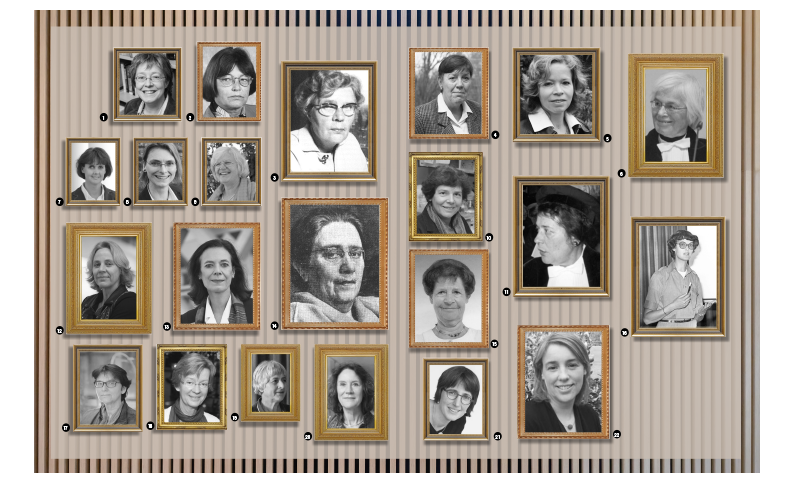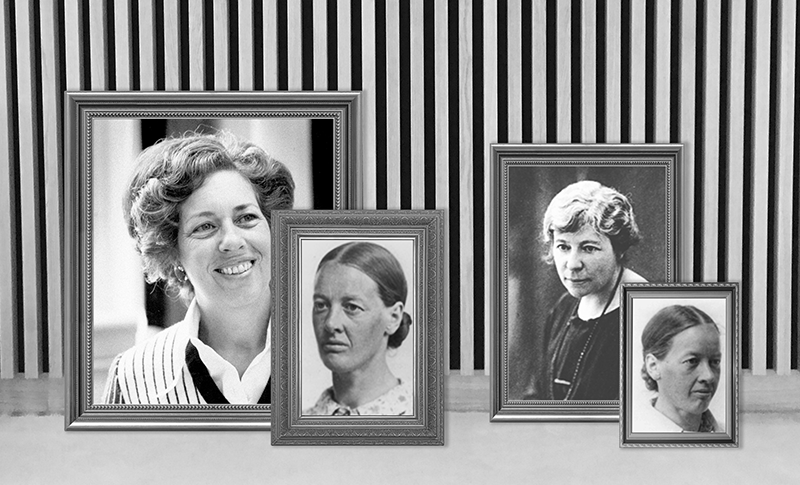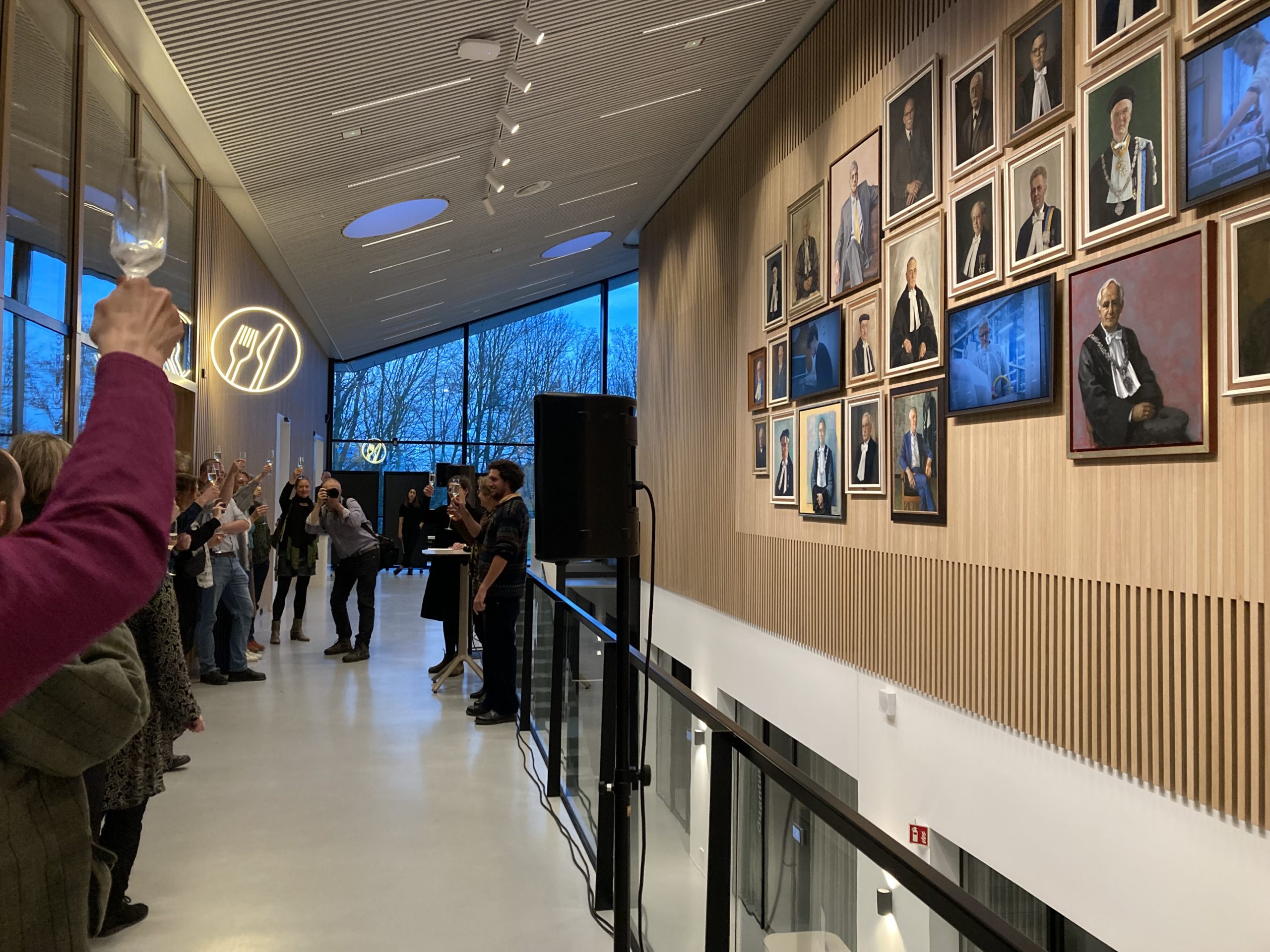Imagine a WUR hall of fame for women only. What would that look like? We gave it a go, as an International Women’s Day Special.
The photo gallery on the following pages is a nod to the discussion about the ‘wall of men’ in Omnia. This portrait gallery opposite the Faculty Club is made up exclusively of men. That can be explained by the dearth of professional portraits of WUR women. But we do have photos of them.
Who belongs in a women’s hall of fame, then? Any selection is somewhat arbitrary. The men’s hall of fame includes rectors and professors, renowned or otherwise, from WUR’s early history. But there hasn’t been a female rector yet, and WUR’s early history didn’t feature any women in the highest academic echelons.
The first woman professor in Wageningen only appeared on the scene in 1952, 34 years after the founding of the National Agricultural College. The honour went to Professor of Agricultural Home Economics Mien Visser. As president of the Dutch Association of Rural Women, Visser helped develop an academic course in Domestic Science at Wageningen. A year later, she also became the new degree programme’s first professor, a position she held for almost a quarter of a century until her sudden death in 1977.
‘Belligerent miss’
So Visser became the first woman professor at Wageningen in 1952. But it really should have been Lucy van Dorp a full 30 years earlier. An economist andlegal expert , Van Dorp was nominated to become professor of Political Economy, Statistics and Dutch Agrarian Law in 1921. This would have given Wageningen the first female chair-holding professor in the Netherlands. However, the then agriculture minister Van IJsselsteyn put a stop to this: he didn’t want a ‘belligerent miss’ becoming a professor. Van Dorp had been an active advocate of women’s suffrage.
Visser was the first woman professor in Wageningen, but not the first woman in a high-level academic job. That was Julia Gouwentak, who was appointed lecturer in Plant Anatomy soon after the war ended in 1945. Gouwentak started as an assistant in the Laboratory of Botany in 1929. In 1938, she married her boss, Professor of Botany Eildert Reinders. She went on to succeed her (much older) husband as professor in 1956. Her appointment didn’t go unopposed – the process took over a year and required two appointment committees. Her opponents took the view ‘that Mrs Reinders’ attitude kills all enthusiasm for botany’. But in the end, Gouwentak was given the benefit of the doubt.
Attempted murder
But her professorship is not Julia Gouwentak’s only claim to fame. She was the first – and happily so far the only – Wageningen professor to be the victim of attempted murder. A Bulgarian political refugee studying in Wageningen shot Gouwentak, who was walking down the street with her husband, with a revolver on 2 January 1960. The forestry student was frustrated at not getting an exemption for the course Gouwentak was teaching. The professor – notorious for her uncompromising nature – was not badly wounded, but the story made all the Dutch newspapers.
Like its male counterpart, the alternative women’s hall of fame on the next page only includes professors. But that wouldn’t have to be the sole criterion. The first female Wageningen graduate would not be out of place in a hall of fame either. That was Frida Eversmann. She studied Agricultural Chemistry at the National College of Agriculture and Horticulture in Wageningen, the predecessor of the Agricultural College. She obtained her degree in 1919 (one year after the Agricultural College opened). And she did so while working at the same institute. In the early years of the Agricultural College, very few women graduated from Wageningen. ‘There were some,’ says Margreet van der Burg, lead author of the book Vrouwen, Wageningen en de Wereld (Women, Wageningen and the World), ‘but they could only sit in on classes because they hadn’t got the requisite secondary or grammar school education.’
Progressive alternative
The first female PhD student was the Frisian Sibergina Wagenaar in 1954. She obtained her PhD on a study of photosynthesis in spinach and other plants. Her thesis ended with the proposition: ‘The emancipation of women is not yet complete in the scientific community in the Netherlands’. She certainly hit the nail on the head there. It took another 20 years before the number of women with Wageningen PhDs reached 10. But even this, according to Van der Burg, does not mean that there were no female PhD holders at the Agricultural College in its early years. ‘It’s just that they didn’t do their PhDs here.’
Her book features many more women who deserve a place in a hall of fame. Like Bernardijn ten Zeldam-Hartelust, the first female president of the College Council in 1973. In 1979, she was also the first woman and feminist to deliver a speech at the opening of the academic year. It was of course about the unequal position of women at the Agricultural College.
And why shouldn’t the twin sisters Eltien and Neeltje Krijthe have a place in the hall of fame? They graduated as horticulturalists in 1934 and then worked at the Agricultural College. During the war, they hid Jewish people in their home, the farm De Wolfswaard in the floodplains, which still exists. They were caught in the act, taken prisoner and deported to concentration camps in Germany. Eltien Krijthe did not survive the camp. Both received the Yad Vashem award in 1973 for non-Jews who saved Jews from persecution.
And what about the first international professor, the Greek Clio Presvelou (Home Economics, 1978)? Or the first female honorary doctor in 1978, the renowned Danish academic Ester Boserup? The Hall of Fame Working Group, tasked with developing a more progressive alternative to the wall of men, has its work cut out for it.
This article was based partly on information from Margreet van der Burg.

1. Edith Feskens, Nutrition (2008-present)
2. Geertje Lycklama à Nijeholt, Emancipation and Women’s Studies (1979-1984)
3. Mien Visser, Agricultural Home Economics (1952-1977)
4. Anke Niehof, Sociology of Consumers and Households (1993-2013)
5. Katrien Termeer, Public Administration and Policy (2015-present)
6. Wija van Staveren, Nutrition and Ageing (1988-2004)
7. Ivonne Rietjens, Toxicology (2000-present)
8. Tinka Murk, Marine Animal Ecology (2015-present)
9. Ariena van Bruggen, Biological Farming Systems (1999-2009)
10. Francine Govers, Phytopathology (2008-present)
11. Clio Presvelou, Home Economics (1978-1989)
12. Imke de Boer, Animal Production Systems (2011-present)
13. Louise Fresco, Plant Production Systems (1990-1997)
14. Cornelia Gouwentak, Botany (1956-1967)
15. Lucie Timmermans, Animal Sciences (1980-1995)
16. Akke van der Zijpp, Animal Production Systems (2000-2010)
17. Grietje Zeeman, New Sanitation (2012-2016)
18. Carolien Kroeze, Environmental Systems Analysis (2010-present)
19. Christa Heyting, Generative and Somatic Cell Genetics (1989-2007)
20. Louise Vet, Evolutionary Ecology (1997-2019)
21. Liesje Mommer, Plant Ecology (2015-present)
22. Rachel Creamer, Soil Biology and Biological Soil Quality (2016-present)

 Bernardijn ten Zeldam-Hartelust, Eltien Krijthe, Lucy van Dorp and Neeltje Krijthe
Bernardijn ten Zeldam-Hartelust, Eltien Krijthe, Lucy van Dorp and Neeltje Krijthe 


Very relevant and important article and research work to increase awareness on the role of women in WUR. It contributes to improve and make more complete our knowledge of the history and present of the WUR. Thanks!